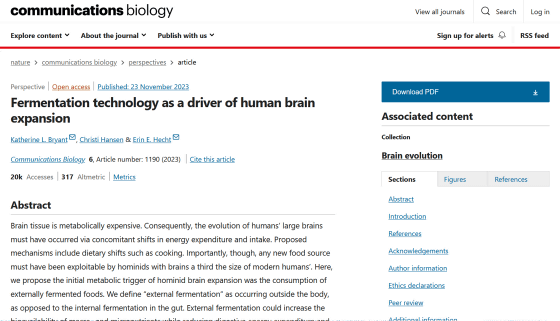Researchers claim that ``fermented foods'' may have made the human brain bigger

Fermentation technology as a driver of human brain expansion | Communications Biology
https://www.nature.com/articles/s42003-023-05517-3

Food Preserving Technique May Have Sparked Human Brain Growth, Scientists Say : ScienceAlert
https://www.sciencealert.com/preparing-food-with-microbes-could-be-why-we-now-have-such-impressive-brains
A major characteristic of the human species is the size of its brain . Australopithecus , an early human, had a brain volume of 400 to 500 ml, about the same size as modern chimpanzees and bonobos, but by the time Homo habilis , which lived about 2.4 million to 1.4 million years ago, had a brain volume of 400 to 500 ml. Brain volume begins to exceed 600 ml, reaching 1350 ml in modern humans (Homo sapiens) .
In other words, the human brain has approximately tripled in size over the past 2 million years, but there are various theories about the mechanism, and nothing is conclusively known yet. Brain tissue consumes a lot of energy, so in order to overcome the risk of starvation and expand the brain, it is necessary to save the necessary calories somewhere in the body.
Many researchers have speculated that the area responsible for the expansion of brain volume by conserving calories is the digestive system. The graph below shows the expected organ mass ratio (left) if humans had the same body structure as other great apes, and the actual organ mass ratio (right) modeled on a 65 kg modern European human. is shown. In the human body, the ``Brain'' is significantly larger than other apes, but the ``Colon'' ratio is 74% smaller than expected. A theory called the `` expensive tissue hypothesis '' holds that the human brain became overwhelmingly larger than that of other apes because the calories saved in the digestive system, including the colon, were diverted to the brain. is.

An important part of the expensive tissue hypothesis is that the intestine itself is responsible for extracting nutrients from food, so shortening the intestine requires changing the food you eat. Specifically, a shift to more energy-dense and easily digestible foods is needed, and some scientists believe that eating more meat, eating more
Based on the expensive tissue hypothesis, Bryant et al. propose the ``external fermentation hypothesis,'' in which fermented foods played an important role in shortening the gastrointestinal tract. The core of this hypothesis is that the intestine itself is an organ that ferments and digests ingested food, and that in fermented foods, part of this fermentation process takes place outside the body.
During internal fermentation, which occurs in the intestines, organic compounds are broken down anaerobically by enzymes produced by microorganisms and yeast living in the digestive system, producing adenosine triphosphate (ATP), which cells use as energy. . Externally fermented foods have more nutrients available than raw foods and require fewer fermentation processes in the body, reducing the size of the intestines and freeing up excess energy for brain expansion. .

The question is whether our ancestors, who had brain volumes comparable to those of great apes, were able to utilize external fermentation, but Bryant et al. We believe that fermentation has been externalized. Fermentation can occur simply by storing food in tree hollows, ground hollows, or caves, so it's possible that our hominid ancestors, who were incapable of planning or using tools, were discovered by chance. It is said that there is a sex.
Bryant et al. write, 'Foresight or an understanding of the mechanism is not a prerequisite for the early stages of ectofermentation; our early ancestors transported food to a common location, left it there, and intermittently 'The transfer of intestinal fermentation to external cultural practices was an important innovation for humans, allowing us to create the metabolic conditions necessary to select for brain expansion.' Maybe it's ready,' he said.
Related Posts:







